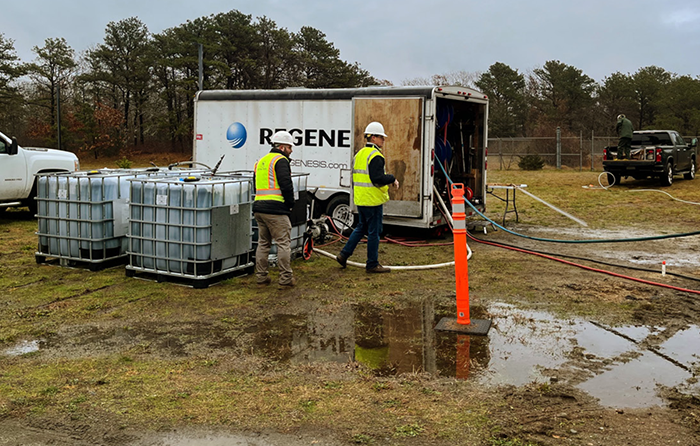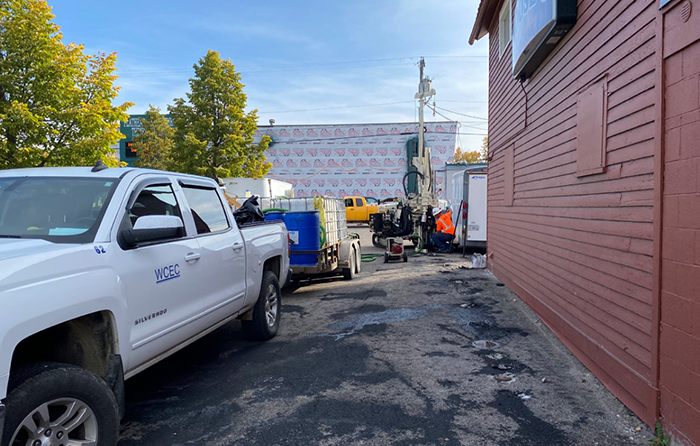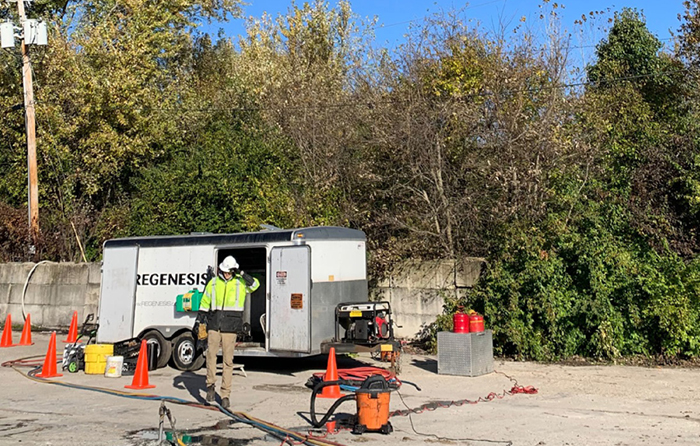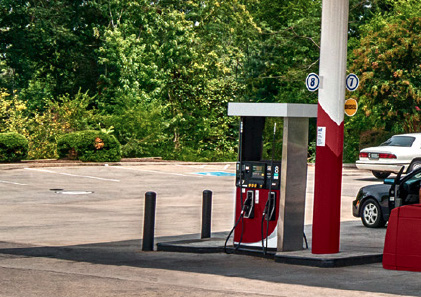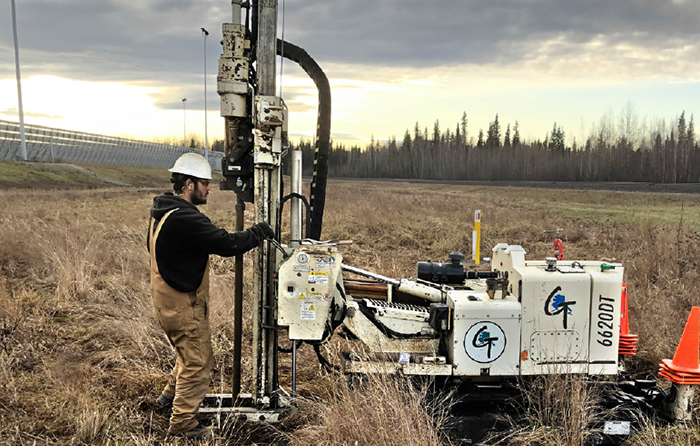Treatment Solution for Large TCE Plume Saves Client $380,000
Case study highlights
At a former manufacturing facility high levels of chlorinated solvents had been released into the groundwater, creating a large plume extending to the nearby river. A combined in situ biogeochemical reduction solution rapidly mitigated the threat to river:
-
Large TCE plume effectively treated using combined technology solution from REGENESIS, including PlumeStop® and S-MicroZVI®
-
Accurate mapping of CVOC flux zones using FluxTracers® saves millions in project cost
-
Safe and efficient installation meets time and budget requirements
6m 38s reading time
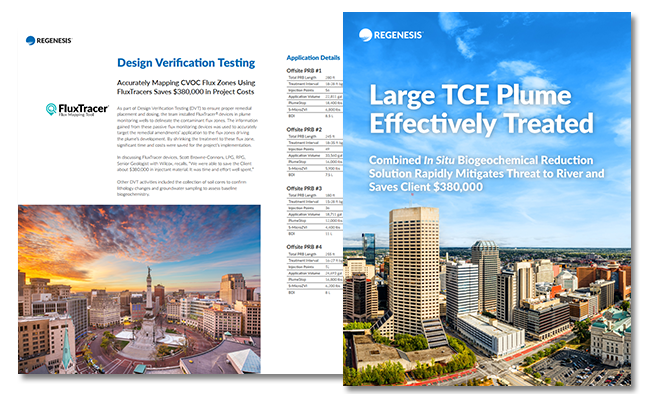
Combined Remedy Rapidly Achieves Targets to Address Chlorinated Solvent Impacts
Case study highlights
-
A multi‑faceted remedial solution mitigates CVOC contamination beneath an active business
-
Successful application overcomes challenging site conditions
-
Groundwater effectively treated using PlumeStop® and
S-MicroZVI®, expediting site closure
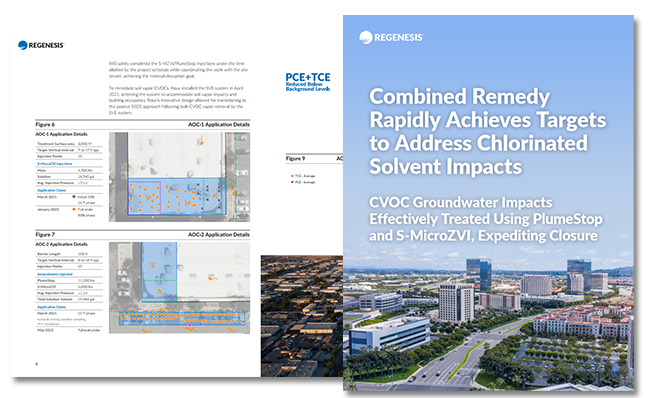
Sustainable and Low-Cost PFAS Source Treatment
Pilot Studies incorporating SourceStop horizontal barrier treatments demonstrate reduction of leaching
This case study reviews the in situ treatment of PFAS source zones at firefighting training areas on two aviation sites where PFAS-containing AFFF was historically discharged. Pilot tests at both sites demonstrated PFAS soil leachate concentrations has been reduced by >99% following the source zone treatments.
The PFAS source treatments applied site-specific amendment blends of SourceStop, a new concentrated form of colloidal activated carbon, in conjunction with powdered activated carbon. SourceStop is a micron scale aqueous carbon suspension emplaced as a horizontal PFAS barrier at the base of the target treatment zones to improve remediation effectiveness dramatically. In controlled laboratory studies, SourceStop has been proven to prevent PFAS leaching with >10x more effectiveness than powdered activated carbon alone.

Case study highlights:
- In situ PFAS source treatments using SourceStop® immediately halt PFAS plume development and prevent impacts to downgradient receptors
- SourceStop approach is a sustainable remediation alternative compared to other mechanical and physical PFAS treatment methods
- Enhanced attenuation removes unacceptable PFAS exposure risk at a low cost
6m 33s reading time
Martha’s Vineyard Airport Successfully Treated Using PlumeStop to Eliminate PFAS Risk
This case study reviews a site at Martha’s Vineyard Airport where a PlumeStop barrier was used to treat PFAS. In less than four months, PlumeStop has eliminated PFAS mass flux immediately downgradient of the barrier and significantly reduced PFAS concentrations further away, as monitoring continues. The cost-effective and sustainable solution to remove PFAS exposure risk provides an alternative to expensive and ineffective pump & treat (P&T) systems.
Tetra Tech, a global environmental consulting firm, has worked with Martha’s Vineyard Airport over the years, addressing a dry-cleaning solvent release and other environmental issues at the site. At the request of the airport, Tetra Tech conducted an initial, preemptive PFAS assessment in 2018, confirming the presence of PFAS, commonly known as “forever chemicals” in groundwater. The remediation goal was to stop further PFAS movement away from the site. Tetra Tech opted for an in situ remediation approach. A PlumeStop injected permeable reactive barrier (PRB) was installed to passively filter PFAS out of groundwater, sorbing the contaminants onto the aquifer matrix and preventing further plume migration.

Case study highlights:
- Cost-effective in situ approach addresses PFAS risk, with no greenhouse gases or hazardous waste produced
- Contaminant flux measurements were obtained using FluxTracer, informing the PlumeStop dose required in the barrier to achieve the treatment objective
- Early performance data show PFAS mass flux eliminated downgradient of PlumeStop barrier, as monitoring continues
7m 16s reading time
Achieving site closure for a large PCE plume in urban area
This case study reviews a former dry cleaner site in a town in Indiana, USA, where site regulatory closure was achieved after a large dissolved-phase PCE groundwater plume was successfully treated using PlumeStop, enhanced reductive dechlorination (ERD) amendments and S-MicroZVI from REGENESIS. Patriot Engineering, a leading environmental consulting firm, specified ERD as the most practical and economically viable method to effectively treat the large plume.
Patriot’s strategy to achieve closure was to significantly reduce the PCE plume and then to demonstrate plume stability through post-remediation monitoring. By combining remediation technologies from REGENESIS with a highly efficient and cost-effective remediation design, Patriot’s treatment approach eliminated the PCE plume. Subsequent performance monitoring and analysis completed by Patriot demonstrated plume stability, earning the site a No Further Action status from the state regulator.

Case study highlights:
- Closure achieved for a large chlorinated solvent plume in an urban area
- A challenging site: located in an urban area with access limitations
- PCE sources rapidly eliminated and plume efficiently treated using a suite of REGENESIS in situ remediation technologies
11m 14s reading time
PetroFix achieves rapid and sustained MTBE reductions below target levels
This case study reviews a successful PetroFix application that placed a Washington underground storage tank (UST) site on track for closure, while saving more than €900,000 in comparison to alternate approaches considered at the site.
The site is a former service station and bulk petroleum plant, where petroleum hydrocarbons were discovered leaking from USTs in the late 1990s. WCEC, an environmental consulting company highly experienced in addressing petroleum-contaminated sites, investigated the site and observed light non-aqueous phase liquids (LNAPL or free product). In response, WCEC completed interim remedial measures, including excavating grossly impacted soils and installing a free product recovery system… Download the case study to learn how a successfull application of PetroFix got the site on track for closure.
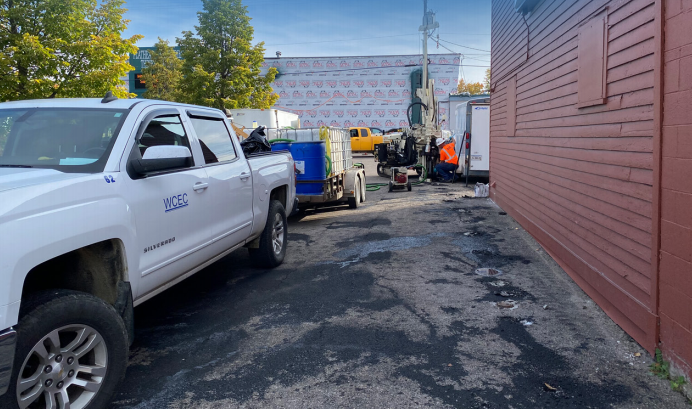
Case study highlights:
- PetroFix achieved rapid and sustained MTBE reductions below cleanup objectives
- At only 8% of the cost of a ‘monitoring-only’ approach, PetroFix saved approximately €1 million for this project
4m 38s reading time
Reducing Time and Cost-to-Closure at UST Release Sites
A multi-site case study
In recent years, environmental consulting firm BJAAM has been using PetroFix® to eliminate risks and obtain regulatory closures at petroleum hydrocarbons impacted UST sites. In this multi-site review we have included 6 sites where BJAAM effectively used PetroFix in support of their risk-based corrective action site closure strategy.
Highlights:
- Site closure achieved at four sites, with the other two eligible for site closure imminently
- Site outcomes have led to significant cost savings for BJAAM’s clients and gained confidence from state UST regulatory agencies in the US.
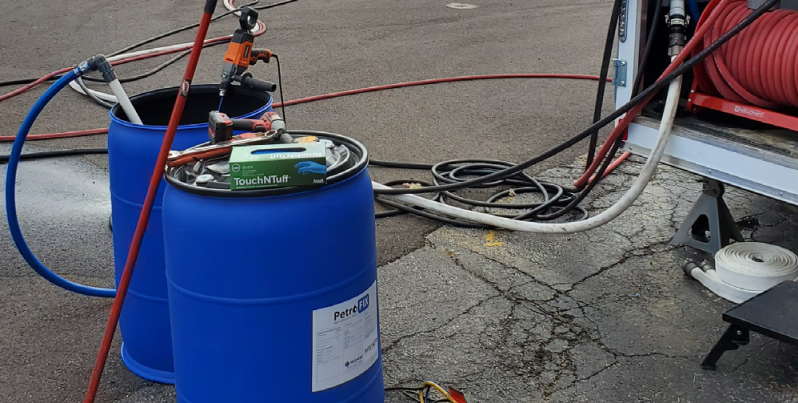
Reductive Dechlorination Approach Treats Large Chlorinated Solvent Plume
Case study highlights:
- Innovative combined remedy on active site effectively eliminates risk to adjacent property
- Remedy from REGENESIS chosen based on proven effectiveness in treating similar large CVOC plumes
- Design Verification Testing and placement validation guide a successful remedial application
This case study reviews the successful in-situ treatment of chlorinated solvents at a former food processing plant located in a suburb south of Indianapolis. PlumeStop, S-MicroZVI, 3DME and BDI Plus were used in combination to strongly inhibit CVOC plume migration near the site property boundary while enhancing abiotic and biotic degradation of CVOCs at this location and in the upgradient plume area. Patriot Engineering and Environmental, Inc. (Patriot), a leading consulting firm based in Indianapolis, investigated the site, discovering contaminants had migrated from an unidentified source and formed a large plume. In addition, it was found that the plume was being pulled toward a former (now inactive) public water supply well. The primary chlorinated volatile organic compounds (CVOCs) detected in the plume were tetrachloroethene (PCE), trichloroethene (TCE), and cis-1,2-dichloroethene (cis-DCE).
Remediation Goals Met Post PetroFix Application
UST release site now poised for closure
After reviewing the available remedial options, Advanced Environmental Technologies, LLC (AET), a leading environmental consulting and engineering firm in the US, determined PetroFix® Remediation Fluid would provide the most economical and efficient means to reduce concentrations below the groundwater cleanup target levels and achieve site closure for this former petrol filling station.
Case study highlights:
- Injecting PetroFix was the lowest cost option and fastest route to site closure
- An air sparge/multi-phase extraction (AS/MPE) system provided significant reductions to PHC concentrations, but was unable to meet required cleanup levels.
- PetroFix application quickly achieves cleanup goals and sustains reductions for over two years (and counting)
4m 21s reading time
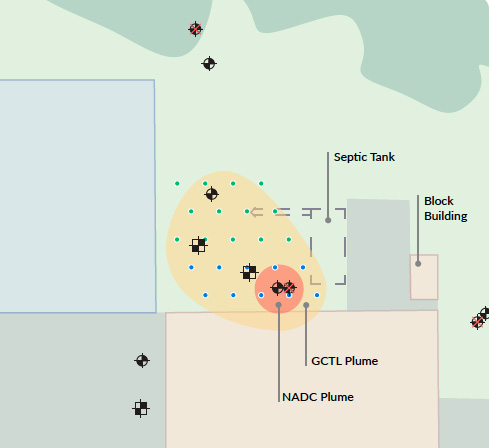
PlumeStop Successfully Remediates PFAS at Alaska Airport
This case study reviews a site where PlumeStop® Colloidal Activated Carbon was applied to treat PFAS resulting from aqueous film-forming foam (AFFF) usage at an airport facility in Alaska. The application has reduced the five targeted PFAS below detection limits and applicable cleanup levels in a challenging hydrogeologic environment over a sampling period now approaching two years. In 2017, Fairbanks International Airport began an investigation in collaboration with the Alaska Department of Environmental Conservation and the Fairbanks office of Shannon & Wilson, a leading Pacific Northwest-based environmental consulting firm, to investigate the extent of PFAS migration from the site. Shannon & Wilson engaged REGENESIS for a pilot test plan to remediate one of the identified AFFF release areas, following successful treatments demonstrated at other sites.
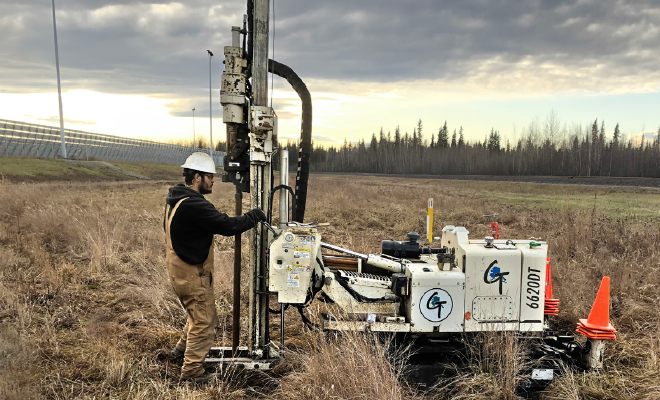
Case study highlights:
- Targeted PFAS contaminants remediated to below detection limits at airport site
- Challenging environmental conditions overcome for a successful PFAS source zone treatment
- PlumeStop application has completely remediated the five individual PFAS targeted, reducing concentrations from 1,200 ng/L to non-detect
7m 31s reading time

 Americas
Americas Europe
Europe Français
Français Deutsch
Deutsch Italiano
Italiano Español
Español


